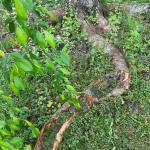UMass Extension's Landscape Message is an educational newsletter intended to inform and guide Massachusetts Green Industry professionals in the management of our collective landscape. Detailed reports from scouts and Extension specialists on growing conditions, pest activity, and cultural practices for the management of woody ornamentals, trees, and turf are regular features. The following issue has been updated to provide timely management information and the latest regional news and environmental data.
To read individual sections of the message, click on the section headings below to expand the content:
Scouting Information by Region
Environmental Data
The following data was collected on or about May 15, 2019. Total accumulated growing degree days (GDD) represent the heating units above a 50° F baseline temperature collected via our instruments for the 2019 calendar year. This information is intended for use as a guide for monitoring the developmental stages of pests in your location and planning management strategies accordingly.
|
MA Region/Location |
GDD |
Soil Temp |
Precipitation |
Time/Date of Readings |
||
|
1-Week Gain |
2019 Total |
Sun |
Shade |
|||
|
CAPE |
7 |
71 |
52 |
48 |
1.36 |
12:00 PM 5/15 |
|
SOUTHEAST |
15 |
100 |
55 |
48 |
1.60 |
3:30 PM 5/14 |
|
NORTH SHORE |
14.5 |
107.5 |
49 |
46 |
1.16 |
9:30 AM 5/16 |
|
EAST |
24 |
134.5 |
57 |
52 |
1.53 |
4:30 PM 5/14 |
|
METRO |
12 |
119.5 |
57 |
55 |
1.14 |
4:30 PM 5/14 |
|
CENTRAL |
13.5 |
132.5 |
42 |
41 |
1.28 |
7:30 AM 5/15 |
|
PIONEER VALLEY |
17.5 |
145.5 |
56 |
50 |
1.67 |
1:30 PM 5/15 |
|
BERKSHIRES |
13.5 |
130.5 |
51 |
45 |
1.87 |
9:30 AM 5/15 |
|
AVERAGE |
15 |
118 |
52 |
48 |
1.45 |
- |
n/a = information not available
Phenology
| Indicator Plants - Stages of Flowering (BEGIN, BEGIN/FULL, FULL, FULL/END, END) | ||||||||
|---|---|---|---|---|---|---|---|---|
| PLANT NAME (Botanic/ Common) | CAPE | S.E. | N.S. | EAST | METRO W. | CENT. | P.V. | BERK. |
|
Aesculus hippocastanum (common horsechestnut) |
* |
Begin/Full |
Begin |
Begin |
* |
* |
Begin |
* |
|
Rhododendron catawbiense (Catawba Rhododendron) |
* |
* |
Full |
* |
* |
* |
* |
* |
|
Elaeagnus umbellata (autumn olive) |
* |
Begin |
Begin |
Begin |
Begin |
Begin |
Begin |
* |
|
Spiraea x vanhouttei (Vanhoutte Spirea) |
* |
Begin |
* |
* |
* |
Begin |
Begin |
* |
|
Rhododendron spp. (early azaleas) |
Begin |
Begin |
Begin/Full |
Begin |
Begin |
Begin |
Begin |
Begin |
|
Syringa vulgaris (common lilac) |
Begin |
Begin |
Begin |
Begin |
Begin |
Begin |
Begin/Full |
Begin |
|
Cornus florida (flowering dogwood) |
Begin/Full |
Begin/Full |
Full |
Full |
Begin |
Begin/Full |
Full |
Begin/Full |
|
Malus spp. (crabapple) |
Full |
Full |
Full |
Full |
Full |
Begin/Full |
Full |
Full |
|
Cercis canadensis (redbud) |
Full/End |
Full/End |
Full |
Full/End |
Full |
Full |
Full/End |
Full |
|
Chaenomeles speciosa (common flowering quince) |
End |
Full/End |
Full/ End |
Full/End |
Full/ End |
Full/End |
Full/End |
Full |
| * = no activity to report/information not available | ||||||||
Regional Notes
Cape Cod Region (Barnstable)
General Conditions: The average temperature over this period has been just under 50˚F with a high of 66˚F on May 11 and a low of 39˚F on May 9. Weekly average temperatures have not really budged over the last 4 weeks. 1.36 inches of precipitation have fallen, spread over 3-4 days of precipitation. The conditions over the period have been primarily cloudy. Good field working days are still few and far between. Top and subsoil moisture conditions are adequate to excessive.
Pests/Problems: Winter moth can be found feeding on susceptible hosts - maple, crabapple, apple, blueberry, and oak. In a brief survey of oak buds last week from the outer Cape, winter moth caterpillars (still very small at about 5mm) were abundant. However, many white oaks on the outer Cape were still in a tight bud stage. Winter moth development in the upper Cape is more advanced, with most caterpillars measuring about 1cm or slightly larger. To date, no gypsy moth egg hatch has been observed. Keep an eye out for Lecanium scale populations on oak. Hydrangea leaftier (Olethreutes ferriferana) is active on Hydrangea arborescens. The weather conditions have been ideal for promoting disease and it maybe a banner year for some diseases like brown rot on Prunus spp and dogwood anthracnose. Other disease signs or symptoms observed over the period include volutella blight on boxwood, Macrophoma leaf spot on boxwood, rust telial horns on juniper, and Iris leaf spot on Iris. Weeds in bloom include mouse ear chickweed (Cerastium vulgatum), dandelion (Taraxacum officinale),garlic mustard (Alliaria petiolata), ivy leaf speedwell (Veronica hederifolia),common blue violet (Viola papilionacea), creeping Charlie (Glechoma hederacea), and yellow rocket (Barbarea vulgaris). Black legged tick nymphs are active. Rabbits are abundant.
Southeast Region (New Bedford)
General Conditions: Temperatures are averaging in the low 50’s and 60’s. Night lows are hovering in the low 40’s and dropped down to 38˚F at the end of the week. Continue to bring your tender annuals inside. With over an inch and half of rain it continues to be a wet cool spring. As a result, many blooms have persisted in the landscape. When the sun does come out everyone is so grateful. Syringa spp. and Malus spp. have begun blooming in New Bedford while Magnolia and Cercis are beginning to fade. Garden soils are moist and a great time for transplanting and planting the landscape.
Pests/Problems: Lots of Hydrangea macrophylla are showing signs of die back and right now is a good time to prune those canes and aborted buds. Garlic mustard, creeping fig, and dandelions are blooming. There are many Japanese maple seedlings this year. Slugs, rabbits, mosquitos, and deer are active in the gardens. There is no sign of winter moth but see the insect section for further details.
North Shore (Beverly)
General Conditions: Cool spring weather persisted during this reporting period, with overcast skies most of the days, rain showers on May 13 and 14, and drizzles on May 10 and 12. Day temperatures were mostly in the low to mid 50s, except on the first two days of the reporting period when day temperatures climbed to the mid-60s. Night temperatures were mostly in the low to mid 40s. During this period, we accumulated 14.5 growing degrees days for a total of 107.5 growing degree days since the beginning of the year. Approximately 1.16 inches of rainfall was recorded during this period. Woody plants seen in bloom during this reporting period include: handkerchief or dove tree (Davidia involucrata), mountain Pieris (Pieris floribunda), flowering dogwood (Cornus florida), redbud (Cercis canadensis), large Fothergilla (Fothergilla major), dwarf Fothergilla (Fothergilla gardenii), royal azalea (Rhododendron schlippenbachii), common lilac (Syringa vulgaris), Kwanzan cherry (Prunus serrulata), crabapple (Malus spp.), hardy orange (Poncirus trifoliata), apple (Malus spp.) and highbush blueberry (Vaccinium corymbosum). Non-woody plants seen in bloom include: daffodil (Narcissus spp.), forget me not (Myosotis sylvatica), tulips (Tulipa spp.), bleeding heart (Dicentra spectabilis), and Vinca vine (Vinca minor).
Pests/Problems: Young larvae of Viburnum leaf beetle (Pyrrhalta viburni) were observed starting to feed on leaves of susceptible Viburnum cultivars. Due to moist soil, weeds are thriving on some lawns and landscapes. Weeds seen in bloom include: dandelion (Taraxacum officinale), ground ivy (Glechoma hederacea)and purple deadnettle (Lamium purpureum). Ticks and mosquitos are very active. Be careful to protect yourself when working outdoors.
East Region (Boston)
General Conditions: Our brief taste of spring was short lived. A weak Nor’easter came through on May 13 and 14. On May 14, we reached only a high of 45˚F. The record daytime low for this date was 47˚F set back in 1931. Over the past week, we received 1.53 inches of precipitation. Daytime temperatures have been relatively cool, ranging from 45 - 69˚F and averaging 58.3˚F, with overnight lows ranging from 40 - 54˚F and averaging 44˚*F. Spring appeared to have arrived in full force on several days when the sun was shining. Azaleas, crabapples, dogwoods and many others are adding color throughout the landscape.
Pests/Problems: Wet and cool conditions have prevailed. The 1.53 inches of precipitation that we have received may be the cause of additional problems in the landscape. Flowering annuals and vegetables remain stagnant and are under attack from slugs which were also seen feeding on Hosta. Bacterial leaf spot (Pseudomonas syringae) is flourishing under the current conditions and has been observed on Viburnums. Browning of evergreens continues to be an issue and may not be solely the result of winter damage. Some evergreens may be suffering from edema, a phenomenon that is basically the slow drowning of the plant. Viburnum leaf beetle larvae continue to feed on susceptible hosts. Winter moth caterpillars have been observed in relatively low numbers. Black swallow wort has emerged. Japanese knotweed is rapidly gaining in height.
Metro West (Acton)
General Conditions: Typical spring-like temperatures continued into this reporting period. It was cold, warm, windy and wet on any given day. The highest temperature recorded for this week was 71°F on the 8tth and the lowest temperature recorded was 33°F on the 19th. The average monthly rainfall for May is 4.04” and as of the 14th I have recorded 1.96”. Much is in bloom at this time of the year, including the following woody plants: Aronia arbutifolia (black chokecherry), Cercis canadensis (redbud), Chaenomeles speciosa (common flowering quince), Cornus florida (dogwood), Daphne x burkwoodii 'Carol Mackie' (Daphne), Fothergilla gardenii (dwarf Fothergilla), F. major (large Fothergilla), Halesia carolina ‘Arnold Pink’ (Arnold Pink silverbell), Halesia tetraptera (mountain silverbell), Ilex aquifolium (English holly), Kerria japonica (Japanese Kerria), Magnolia x loebneri 'Merrill' (Merrill Magnolia), M. x soulangeana (saucer Magnolia), M. 'Butterflies' (butterflies Magnolia), M. 'Yellow Lantern’ (yellow lantern Magnolia), Malus spp. (apple, crabapple), Prunus spp. [cherry - including Prunus serrulata 'Kwanzan' (Japanese flowering cherry), P. japonica (flowering almond), P. serotina (black cherry)], Rhododendron spp. [early flowering Rhododendron/Azalea - including R. vaseyii (pink shell azalea)], Spiraea spp. (bridal wreath), Syringa spp.(early blooming lilac), Syringa vulgaris (common lilac), Vaccinium angustifolium (lowbush blueberry), V. corymbosum (highbush blueberry), Viburnum x burkwoodii (Burkwood Viburnum) and V. x burkwoodii 'Mohawk' (Mohawk Burkwood Viburnum), and Viburnum × juddii (Judd Viburnum).
Contributing even more color and interest to the landscape are some flowering herbaceous plants and spring ephemerals including: Actaea pachypoda (white baneberry), Aquilegia canadensis (columbine),Arisaema triphyllum (Jack-in-the-pulpit), Aurinia saxatilis (basket of gold), Brunnera macrophylla (Alkanet), Caltha palustris (marsh marigold), Claytonia virginica (Virginia spring beauty), Convallaria majalis (lily of the valley), Dicentra eximia (fringed bleeding heart), D. spectabilis (old fashioned bleeding heart), D. spectabilis 'Alba' (white flowering old fashioned bleeding heart), Dodecatheon meadia (shooting star), Epimedium x versicolor 'Niveum' (white flowering barrenwort), E. x versicolor 'Roseuem' (pink flowering barrenwort), E. versicolor 'Sulphureum' (yellow flowering barrenwort), Gallium odorata (sweet woodruff), Linaria annua (money plant), Mertensia virginica (Virginia bluebells), Muscari sp. (grape hyacinth), Myosotis sylvatica (forget-me-not), Narcissus spp. (daffodil), Phlox x subulata (moss Phlox), Podophyllum peltatum (Mayapple), Polemonium reptans (Jacob’s ladder), Polygonatum biflorum var. commutatum (great Solomon’s seal), P. odoratum 'Variegatum' (variegated Solomon’s seal), Primula spp. (primrose), Stylophorum diphyllum (wood poppy), Tiarella cordifolia (foam flower), Trillium erectum (red flowering Trillium), T. grandiflorum (white flowering Trillium), T. sessile (toadshade), Tulipa spp. (tulip), Uvularia sessilifolia (bellflower), Vinca minor (periwinkle), Viola spp. (violet), and Waldsteinia ternata (barren strawberry).
Pests/Problems: Ticks, mosquitoes and black flies are feeding and active. Many weeds are in flower including a few of the nastiest invasives of all time - Alliaria petiolata (garlic mustard), which is easily seen with its white flowers growing on roadsides and in woodlands, wetlands and gardens, Elaeagnus umbellata (autumn-olive), and Lonicera maackii (Amur honeysuckle). Other weeds seen in bloom now are Glechoma hederacea (ground ivy), Lamium purpureum (purple dead nettle) and Taraxacum officinale (dandelion).
Central Region (Boylston)
General Conditions: It felt like we were moving backwards this week. Warm, sunny, and relatively dry to start the week, followed by a trip back to what felt like March for the latter half of the week. The cold, drawn out spring is certainly making for a long spring bloom period. Daffodils are finally petering out, but many tulips are holding strong. Mertensia virginica (Virginia bluebells) and Trillium luteum (yellow trillium) are at peak bloom. Malus spp. (apples and crabapples) and Tiarella cordifolia (foamflower) began blooming this week. The potential for frost this time of year can devastate peaches and apples, so evening temperatures in the mid-30’s this week gave us pause, but we did not see any signs of frost after those very cold evenings.
Pests/Problems: There are still no significant landscape problems. Despite the rain, this has been a relatively pest free spring thus far. We’re onto a third round of treatment for fire blight, apple scab, and rust on apples, but thus far very few signs of foliar disease anywhere. Gypsy moths are definitely active, but we’re hoping all this wet weather encourages Entomophaga maimaiga, the fungal pathogen that keeps them in check most years.
Pioneer Valley Region (Amherst)
General Conditions: Unseasonably cold temperatures with overcast skies and locally heavy rain developed over this past reporting period in the Pioneer Valley. Since our last report, high temperatures took a nose dive into to the upper 40s and lower 50s as the UMass campus cleared out following graduation. Low temperatures followed suit, dropping into the upper 30s and lower 40s from 5/12 to 5/15. The reporting period began with mild, spring-like weather with scattered sun and clouds. Saturday, 5/11 was a dream-like day with sun and highs in the upper 60s. Then a cold air mass settled in the region on Mother’s Day, bringing bitter rain and even snow to the western valley hill towns. More than 1.5” of rain accumulated on 5/12 and 5/13, sending soils right back to saturation in some locations. Soil temperatures also dropped back in the lower to middle 50s. The cool temperatures helped to prolong the flowering period for many woody and herbaceous plants yet again. The temperature drop has also delayed leaf and shoot development for many trees and shrubs. Oaks continue to exhibit leaves that can’t be more than 25% their normal size. White fir, eastern hemlock, arborvitae, and Hinoki falsecypress are pushing new growth at this time. Candles on soft and hard pines are also extending. Winds were gusty on 5/13 and numerous succulent shoots and developing leaves were found littered around mature trees in the aftermath. The long-term forecast suggests we may be finally settling into more seasonal temperatures in the upper 60s and 70s, but that the frequent rain will continue on.
Pests/Problems: Foliar anthracnose diseases are beginning to appear on the landscape. Symptoms of infection have been observed on lilac and sugar maple. Sycamore is having difficulty leafing out as many new shoots and leaves are killed by sycamore anthracnose. Gypsy moth feeding slowly continues in the Amherst area on a wide array of deciduous trees and shrubs. While caterpillars are still very small, it’s easy to find feeding damage throughout the landscape. The persistent rain and slow leaf development on some trees and shrubs has made treatment difficult. Invasive plants are abundant and growing strong at this time. Japanese knotweed, Oriental bittersweet, multiflora rose and garlic mustard are some of the most common in the valley at this time. Now is the perfect time to address mowing injury to trees and shrubs, a common and easily correctable stress in the landscape. Establishing a large mulch ring around trees not only protects lateral roots from repeated mower injury but it also suppresses weeds and invasive plants while helping to maintain soil moisture. Pictured below is a mature weeping Higan cherry on the UMass campus that has been repeatedly injured by lawn mowing, the latest offense occurring on 5/14. Now that eastern hemlocks and true firs are pushing new growth, it’s time to start planning elongate hemlock scale treatments. Scout the underside of lower canopy branches to determine if this destructive, non-native pest is present. If it’s not present, treatment is unnecessary. Lower trunk sprays with Safari are the quickest and most effective treatment and should provide multi-year protection. Because these trees are wind-pollinated, pollinator exposure will be extremely limited, especially when applied as a bark drench. According to the Cold Spring Orchard in Belchertown, fire blight activity has been very low. The cool temperatures and lack of pollinator activity has kept the disease suppressed to date.
Berkshire Region (Great Barrington)
General Conditions: The past week was more of the same weather wise, that is, much cooler than normal and wet. Five of the seven days from May 8 to May 15 experienced rain. According to weather data collected at the Pittsfield Airport, only 3 days thus far this month have been rain-free. On Sunday, May 12, and Monday, May 13, a heavy wet snow fell in towns at the highest elevations. The snow amounted to a little more than an inch in some of those towns, located at the eastern edge of the county. Snow mixed with rain fell in most other locales. The high temperature from May 8-14 was 65˚F (May 9 & 10). The low temperature was 35˚F on the morning of May 14. Needless to say, the soil in most areas remains saturated. Yet, turfgrass is growing vigorously, requiring frequent mowing. However, where riding mowers were used, it was not uncommon to see ruts following mowing. Plant development during this time is slow but steady.
Pests/Problems: The first symptoms of disease were found during scouting on May 15. The beginnings of fire blight were noticed on a sand cherry, a specimen with a long track record of this infection. Also, observed were the tiny necrotic spots of apple scab on crabapples. Leaf spots were also observed on foliage of silver linden (Tilia tomentosa). UMass Extension Plant Pathologist, Nick Brazee, reports that he has received the first samples of boxwood blight from Berkshire County. The disease had not been previously found in the County.
Shallow holes in turfgrass have been quite noticeable in many places. The likely cause is nocturnal digging by skunks in search of grubs. Turf managers observing such diggings should lift sections of sod to verify presence of grubs before initiating grub control measures. Viburnum leaf beetle larvae, boxwood leaf miner larvae, and eastern tent caterpillar larvae are all actively feeding on plant foliage. Despite rain and cool temperatures, the reports of deer tick attachment to outdoor workers and woodland hikers are frequent. Cutworm activity has also been observed but mostly in vegetable gardens and in plantings of annual flowers.
Regional Scouting Credits
- CAPE COD REGION - Russell Norton, Horticulture and Agriculture Educator with Cape Cod Cooperative Extension, reporting from Barnstable.
- SOUTHEAST REGION - Kristin McCullin, Horticulturist reporting from Haskell Public Gardens, New Bedford.
- NORTH SHORE REGION - Geoffrey Njue, Green Industry Specialist, UMass Extension, reporting from the Long Hill Reservation, Beverly.
- EAST REGION - Kit Ganshaw & Sue Pfeiffer, Horticulturists reporting from the Boston area.
- METRO WEST REGION – Julie Coop, Forester, Massachusetts Department of Conservation & Recreation, reporting from Acton.
- CENTRAL REGION - Mark Richardson, Director of Horticulture reporting from Tower Hill Botanic Garden,Boylston.
- PIONEER VALLEY REGION - Nick Brazee, Plant Pathologist, UMass Extension Plant Diagnostic Lab, reporting from UMass Amherst.
- BERKSHIRE REGION - Ron Kujawski, Horticultural Consultant, reporting from Great Barrington.
Woody Ornamentals
Diseases
Recent pests and pathogens of interest seen in the UMass Extension Plant Diagnostic Lab https://ag.umass.edu/services/plant-diagnostics-laboratory:
Needle browning and branch dieback of yews (Taxus cuspidata and T. x hunnewelliana) caused by winter burn and Cryptocline needle blight (Cryptocline taxicola). The Japanese yew is approximately 50-years-old and resides at a well-maintained college campus. In spring of 2018, ~20% of the canopy was browning but after this past winter, the entire canopy was symptomatic. The setting includes full sun on the southeast side of a building with poorly-drained soils. The Hunnewell yew is approximately 100-years-old and resides in an arboretum with partial shade. Needle browning and canopy dieback has been progressively worsening since 2017. The lab has received several yew samples infected by Cryptocline this spring, suggesting the disease may be more prominent in 2019. Yews have very few associated pathogens and when well-established, Cryptocline causes significant browning and premature needle shedding.
Brown needle spot, caused by Lecanosticta acicola, on Japanese black pine (Pinus thunbergii). The tree is 20-years-old and has been present at the site for 10 years. Conditions include sandy loam soils with full sun. The tree is one of many planted on a minor slope and began exhibiting needle browning in autumn of 2018. Like many needle blight pathogens of conifers, Lecanosticta (formerly Mycosphaerella)infects needles in the spring and early summer but symptoms do not develop until several months later. Brown needle spot is one of the primary diseases impacting eastern white pine in the region but the fungus responsible can attack numerous species of pine.
Boxwood blight, caused by the fungal pathogen Calonectria pseudonaviculata, on Winter Gem boxwood (Buxus sinica var. insularis 'Winter Gem'). Plants are seven- to ten-years-old and were transplanted two years ago. The planting beds are close to a home with full sun but have wet, poorly-drained soils. This spring, leaf spots and stem lesions became visible and the fungus was found sporulating from submitted branches. No symptoms were visible in 2018. Korean boxwood is considered somewhat resistant to boxwood blight but all species and cultivars are susceptible to infection and death from the disease.
Leaf yellowing and dieback of cherry laurel (Prunus laurocerasus) caused by cherry leaf spot (Blumeriella jaapii), Phomopsis stem cankering and bacterial shot hole (Pseudomonas syringae). The age is unknown but the tree was transplanted to the site approximately one year ago. The site includes shade and supplemental water through drip irrigation. Cherry leaf spot can be a serious disease of Prunus, resulting in leaf yellowing and premature leaf shedding. Stem cankering by Phomopsis is often a stress-related condition and was likely facilitated by transplant shock. Bacterial shot hole has been common on landscape Prunus since 2017. The damage appears similar to insect feeding but is often not particularly damaging or warranting intervention.
 Foliar anthracnose of lilac (Syringa vulgaris) caused by Colletotrichum. The plant is 20-years-old and exhibited anthracnose-like symptoms after leafing out this spring. The symptoms were not present in years past and include: marginal browning, angular leaf spots and blotches, leaf distortion and curling. The submitted sample had abundant pinkish-colored spore masses on the blighted leaf sections (see photo). Colletotrichum is a common foliar pathogen in the region, attacking a wide array of trees and shrubs.
Foliar anthracnose of lilac (Syringa vulgaris) caused by Colletotrichum. The plant is 20-years-old and exhibited anthracnose-like symptoms after leafing out this spring. The symptoms were not present in years past and include: marginal browning, angular leaf spots and blotches, leaf distortion and curling. The submitted sample had abundant pinkish-colored spore masses on the blighted leaf sections (see photo). Colletotrichum is a common foliar pathogen in the region, attacking a wide array of trees and shrubs.
Report by Nick Brazee, Plant Pathologist, UMass Extension Plant Diagnostic Lab, UMass Amherst.
Insects
A New, Interactive Tool to Protect Massachusetts Pollinators:
The Massachusetts Department of Agricultural Resources (MDAR) has recently released “MAPL”: The Massachusetts Apiary and Pesticide Locator. This is a voluntary, interactive mapping tool designed to facilitate real-time communication between beekeepers and pesticide applicators. MAPL allows beekeepers to voluntarily submit the location of their hives in Massachusetts and pesticide applicators to voluntarily submit the location of pesticide applications they are making in the state. The information provided by both parties is not verified by the Department and may not represent all apiary locations or pesticide applications in Massachusetts. To enter your information, or view information shared by others, visit MAPL here: https://eeaonline.eea.state.ma.us/DAR/Apiary/UI/
Woody ornamental insect and non-insect arthropod pests to consider, a selected few:
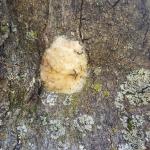

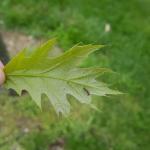
 Gypsy Moth:(Lymantria dispar) host plants include but are certainly not limited to oak (favored), maple, birch, poplar, and many others. Gypsy moth eggs have hatched and young caterpillars have ballooned to disperse and are feeding on susceptible host plants. Professionals in Millis, MA reported gypsy moth egg hatch (with photo evidence) on 4/23/19. Elizabeth Garofalo, Integrated Pest Management Specialist with UMass Extension’s Fruit Program observed gypsy moth egg hatch in Belchertown, MA (Hampshire County) on 4/23, 4/25, 5/2, and 5/6/2019 as reported in “Hawkeye’s Corner” of the Healthy Fruit Newsletter, available here: https://ag.umass.edu/fruit/publications/healthy-fruit . Professionals, Extension educators, and state collaborators have also reported gypsy moth egg hatch having occurred in Barre, MA on 5/3/19 (Worcester County), Hubbardston, MA on 5/6/19 (Worcester County), Shrewsbury, MA on 5/6/19 (Worcester County), Leicester, MA in the village of Rochdale on 5/7/19 (Worcester County), and in Chesterfield, MA on 5/11/19 (Hampshire County). (In the Chesterfield location, there aren’t very many egg masses and feeding damage from caterpillars has not been noticed in recent years.) Tiny, mostly first instar caterpillars were observed feeding on elm, oak, and witch hazel on the University of Massachusetts, Amherst campus on 5/13/19. When viewed from above, some leaves may have small, irregularly shaped holes visible. If you flip those leaves over, you may encounter one or more tiny, hairy, and dark-colored caterpillars.
Gypsy Moth:(Lymantria dispar) host plants include but are certainly not limited to oak (favored), maple, birch, poplar, and many others. Gypsy moth eggs have hatched and young caterpillars have ballooned to disperse and are feeding on susceptible host plants. Professionals in Millis, MA reported gypsy moth egg hatch (with photo evidence) on 4/23/19. Elizabeth Garofalo, Integrated Pest Management Specialist with UMass Extension’s Fruit Program observed gypsy moth egg hatch in Belchertown, MA (Hampshire County) on 4/23, 4/25, 5/2, and 5/6/2019 as reported in “Hawkeye’s Corner” of the Healthy Fruit Newsletter, available here: https://ag.umass.edu/fruit/publications/healthy-fruit . Professionals, Extension educators, and state collaborators have also reported gypsy moth egg hatch having occurred in Barre, MA on 5/3/19 (Worcester County), Hubbardston, MA on 5/6/19 (Worcester County), Shrewsbury, MA on 5/6/19 (Worcester County), Leicester, MA in the village of Rochdale on 5/7/19 (Worcester County), and in Chesterfield, MA on 5/11/19 (Hampshire County). (In the Chesterfield location, there aren’t very many egg masses and feeding damage from caterpillars has not been noticed in recent years.) Tiny, mostly first instar caterpillars were observed feeding on elm, oak, and witch hazel on the University of Massachusetts, Amherst campus on 5/13/19. When viewed from above, some leaves may have small, irregularly shaped holes visible. If you flip those leaves over, you may encounter one or more tiny, hairy, and dark-colored caterpillars.
Timing management options, such as applications of Bacillus thuringiensis kurstaki (Btk), early may be prudent if you find many of these young caterpillars feeding on valuable hosts in the landscape. Remember, Btk must be ingested by the caterpillars to be effective, and it is best used on young, more vulnerable gypsy moth caterpillars roughly ¾ inch in length or smaller.
Despite the fungal outbreak that swept through the 2017 caterpillar population, some lucky caterpillars survived to pupation and emerged as adult moths. (However, adults were present in 2017 in far fewer numbers than would have existed without the fungus.) In 2018, the Massachusetts Department of Conservation and Recreation (DCR) reported that approximately 159,705 acres were defoliated by gypsy moth caterpillars in pockets across the state. While this may seem negligible in comparison to the 923,186 acres of defoliation due to gypsy moth in 2017, for many communities the impact was still significant. MA DCR also surveyed multiple locations across the state for overwintering gypsy moth egg masses in December of 2018. They provide a map of their predictions of where pockets of defoliation may occur in 2019 based on the densities of egg masses they observed in monitored areas across the state. Many of these areas correspond with the locations previously defoliated by gypsy moth caterpillars in 2018. MA DCR predicts gypsy moth activity will occur this season in regionalized pockets of Essex, Hampden, Hampshire, Middlesex, Norfolk, Plymouth, and Worcester Counties. Maps of previous year’s defoliation as well as the 2018 overwintering gypsy moth egg mass survey may be found here, courtesy of the MA DCR: https://www.mass.gov/guides/gypsy-moth-in-massachusetts .
While it is very difficult to predict how much defoliation Massachusetts will see in 2019 due to gypsy moth caterpillar feeding, we can be certain that in areas where many egg masses overwintered, pockets of defoliation could still occur in certain areas of the state this year.
- Winter Moth: (Operophtera brumata) The winter moth population in eastern Massachusetts continues to be at record lows in most locations, and Dr. Joseph Elkinton, Professor of Environmental Conservation at the University of Massachusetts, is declaring victory over this pest! In case you have missed this news from last year, a recent edition of the UMass Magazine discusses the winter moth story and successes with the biological control of this insect (along with some fun and excellent illustrations): https://www.umass.edu/magazine/spring-2019/winter-moth .
Winter moth caterpillars were reported on 4/19/19 in apple buds on the upper Cape and on 4/26/19 in Barnstable, MA on susceptible hosts. See the Regional Reports above for current updates. Heather Faubert of the University of Rhode Island Cooperative Extension reported fewer winter moth eggs on trees monitored in Franklin, MA this spring and reported winter moth egg hatch beginning around April 10, 2019 at sites monitored in Franklin, MA and locations in Rhode Island.
In landscape settings in eastern Massachusetts, it is best to wait until the leaves of susceptible hosts completely unfold and monitor for feeding caterpillars, prior to treatment, especially since populations in Massachusetts continue to be so low in many locations where Cyzenis albicans, the fly used in the biological control of this pest, has become established. Be sure that management of winter moth is necessary by monitoring for damaging populations before making applications in landscape settings. There may be some locations where winter moth caterpillars can be found while C. albicans catches up with the population. For more information about the life cycle and management of winter moth, please visit thisfact sheet: Winter Moth Identification and Management https://ag.umass.edu/landscape/fact-sheets/winter-moth-identification-management .
Winter moth is a non-native insect that was identified in Massachusetts for the first time in 2003 following persistent reports of defoliation in eastern areas of the state such as Cape Anne and on the North Shore near Cohasset, Hingham, and Rockland on the South Shore in the late 1990’s. For more detailed information about the history of this insect pest in North America and Massachusetts, please visit this fact sheet: Winter Moth in Massachusetts: History and Biological Control https://ag.umass.edu/landscape/fact-sheets/winter-moth-in-massachusetts-history-biological-control .
- Asian Longhorned Beetle: (Anoplophora glabripennis, ALB) Look for signs of an ALB infestation which include perfectly round exit holes (about the size of a dime), shallow oval or round scars in the bark where a female has chewed an egg site, or sawdust-like frass (excrement) on the ground nearby host trees or caught in between branches. Be advised that other, native insects may create perfectly round exit holes or sawdust-like frass, which can be confused with signs of ALB activity.
The regulated area for Asian longhorned beetle is 110 miles2 encompassing Worcester, Shrewsbury, Boylston, West Boylston, and parts of Holden and Auburn. If you believe you have seen damage caused by this insect, such as exit holes or egg sites, on susceptible host trees like maple, please call the Asian Longhorned Beetle Eradication Program office in Worcester, MA at 508-852-8090 or toll free at 1-866-702-9938.
To report an Asian longhorned beetle find online or compare it to common insect look-alikes, visit: http://massnrc.org/pests/albreport.aspx or https://www.aphis.usda.gov/pests-diseases/alb/report .
- Balsam Twig Aphid: Mindarus abietinus is active between 30-100 GDD’s, base 50°F. Inspect the needles of Balsam fir, Fraser fir, and other true firs for “stem mothers” that will soon be reproducing. Young aphid feeding will lead to distorted foliage. (Needles curl.) Excessive amounts of honeydew are produced and cause needles to stick together. Monitor for the presence of reproducing females and treat with an oil application as weather permits, according to label instructions.
- Deer Tick/Blacklegged Tick: Check out the archived FREE TickTalk with TickReport webinars available here:https://ag.umass.edu/landscape/education-events/webinars . The next live webinar will be held on October 9, 2019 with Dr. Stephen Rich of the UMass Laboratory of Medical Zoology. Previous webinars including information about deer ticks and associated diseases, American dog ticks and lone star ticks and associated diseases, ticks and personal protection, and updates from the Laboratory of Medical Zoology are archived at the link above.
Ixodes scapularis adults have been active all winter, as they typically are from October through May, and “quest” or search for hosts at any point when daytime temperatures are above freezing. Deer tick nymphs (immatures) are also active at this time, and may be encountered now through August. For images of all deer tick life stages, along with an outline of the diseases they carry, visit: http://www.tickencounter.org/tick_identification/deer_tick .
Anyone working in the yard and garden on springtime cleanup and planting should be aware that there is the potential to encounter deer ticks. The deer tick or blacklegged tick can transmit Lyme disease, human babesiosis, human anaplasmosis, and other diseases. Preventative activities, such as daily tick checks, wearing appropriate clothing, and permethrin treatments for clothing (according to label instructions) can aid in reducing the risk that a tick will become attached to your body. If a tick cannot attach and feed, it will not transmit disease. For more information about personal protective measures, visit: http://www.tickencounter.org/prevention/protect_yourself .
Have you just removed an attached tick from yourself or a loved one with a pair of tweezers? If so, consider sending the tick to the UMass Laboratory of Medical Zoology to be tested for disease causing pathogens. To submit a tick to be tested, visit: https://www.tickreport.com/ and click on the blue “Order a TickReport” button. Results are typically available within 3 business days, or less. By the time you make an appointment with your physician following the tick attachment, you may have the results back from TickReport to bring to your physician to aid in a conversation about risk.
The UMass Laboratory of Medical Zoology does not give medical advice, nor are the results of their tests diagnostic of human disease. Transmission of a pathogen from the tick to you is dependent upon how long the tick had been feeding, and each pathogen has its own transmission time. TickReport is an excellent measure of exposure risk for the tick (or ticks) that you send in to be tested. Feel free to print out and share your TickReport with your healthcare provider.
- Eastern Spruce Gall Adelgid: Adelges abietis is a pest of Norway spruce primarily, but occasionally damages other spruce species. This adelgid overwinters as a partially grown female, often referred to as a stem mother. This overwintering individual matures around bud break and lays 100-200 eggs. The eastern spruce gall adelgid may be targeted for management between 22-170 GDD’s, base 50°F.
- Eastern Tent Caterpillar: Malacosoma americanum eggs have hatched. Susceptible hosts include cherry and crabapple. Other host plants whose leaves are fed upon by this native insect can include apple, ash, birch, willow, maple, oak, poplar, and witch-hazel. Eastern tent caterpillars are native to Massachusetts and have many associated natural enemies (parasites and predators) that help regulate populations. Unless these caterpillars are actively defoliating specimen trees in a landscaped setting, we can coexist with this particular herbivore native to our forests.
- Elongate Hemlock Scale: Fiorinia externa is found on eastern, Carolina, and Japanese hemlock, as well as yew, spruce, and fir. Crawlers will be present this month and throughout the growing season and the overlap of many developmental stages at any given time can be observed. Treatments for the crawler, or mobile, stage of this insect may be made in late May through mid-June, or between 360-700 GDD’s, base 50°F.
- Emerald Ash Borer: (Agrilus planipennis, EAB) Since the New Year, the Massachusetts Department of Conservation and Recreation has confirmed 26 new community detections of emerald ash borer in Massachusetts. While the cities and towns with recent detections of EAB are too numerous to list here, they are in areas of Berkshire, Hampden, Hampshire, Middlesex, and Worcester counties. A map of these locations and others previously known across the state may be found here: https://ag.umass.edu/fact-sheets/emerald-ash-borer .
This wood-boring beetle readily attacks ash (Fraxinus spp.) including white, green, and black ash, has also been found developing in white fringe tree (Chionanthus virginicus), and has been reported in cultivated olive (Olea europaea). Adult insects of this species will not be present at this time of year. Signs of an EAB infested tree may include (at this time) D-shaped exit holes in the bark (from adult emergence in previous years), “blonding” or lighter coloration of the ash bark from woodpecker feeding (chipping away of the bark as they search for larvae beneath), and serpentine galleries visible through splits in the bark, from larval feeding beneath. Positive identification of an EAB-infested tree may not be possible with these signs individually on their own.
For further information about this insect, please visit: https://ag.umass.edu/fact-sheets/emerald-ash-borer . If you believe you have located EAB-infested ash trees, particularly in an area of Massachusetts not identified on the map provided, please report here: http://massnrc.org/pests/pestreports.htm .

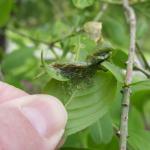 Euonymus Caterpillar: Yponomeuta cagnagella is of European origin and widespread in distribution throughout Europe. It was first reported in North America in Ontario in 1967. Tiny, overwintered euonymus caterpillars are actively spinning webs and feeding on new 2019 European spindle tree foliage in Amherst, MA as observed on 5/14/2019.
Euonymus Caterpillar: Yponomeuta cagnagella is of European origin and widespread in distribution throughout Europe. It was first reported in North America in Ontario in 1967. Tiny, overwintered euonymus caterpillars are actively spinning webs and feeding on new 2019 European spindle tree foliage in Amherst, MA as observed on 5/14/2019.
The euonymus caterpillars (larvae) feed in groups and envelop the foliage of the host plant in webs as they feed. Hosts include: Euonymus europaeus (tree form), E. kiautschovicus, E. alatus, and E. japonicus. Mature caterpillars are just under an inch in length, creamy yellow-gray in color with black spots and a black head capsule. By late June, these larvae pupate in white, oval-shaped cocoons which are typically oriented together vertically either on host plants or non-hosts in the area. Cocoons can be found in cracks and crevices, or webbed together leaves. The adult moth emerges in late June in most locations. The adult female secretes a gummy substance over her eggs which will harden, making them even more difficult to see. Eggs hatch by mid-August, at which time the tiny larvae prepare to overwinter beneath their eggshell-like covering. These larvae are inactive until the following year, when caterpillars group together to feed on newly emerging leaves, creating a mess of webs as they feed. There is one generation per year. Plants may be partially or entirely defoliated. Management of young, actively feeding caterpillars with Bacillus thuringiensis is possible if deemed necessary, however many species of Euonymus are considered invasive themselves.
- European Pine Sawfly: Neodiprion sertifer caterpillars are active roughly between 78-220 GDD, base 50°F. The primary host in MA is Mugo pine but it can be found on Scots, red, jack, and Japanese red pine, and also on white, Austrian, ponderosa, shortleaf, and pitch pine when near the aforementioned species. This dark colored caterpillar feeds in tight groups and small numbers can be pruned or plucked out of host plants and destroyed. Larger numbers can be treated with an insecticidal soap spray when the caterpillars are still small. Spinosad products can be used whenever the caterpillars are actively feeding, usually by mid-May and when caterpillars are still small. Bacillus thuringiensis kurstaki is not effective against sawflies.
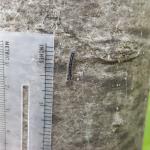
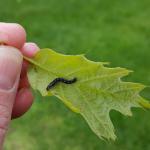 Forest Tent Caterpillar: Malacosoma disstria egg hatch has occurred and caterpillars were observed feeding on oak leaves in Amherst, MA on 5/14/19. Individuals of this native insect may be found feeding alongside gypsy moth caterpillars in the same location. Susceptible hosts whose leaves are fed on by this insect include oak, birch, ash, maple, elm, poplar, and bassw
Forest Tent Caterpillar: Malacosoma disstria egg hatch has occurred and caterpillars were observed feeding on oak leaves in Amherst, MA on 5/14/19. Individuals of this native insect may be found feeding alongside gypsy moth caterpillars in the same location. Susceptible hosts whose leaves are fed on by this insect include oak, birch, ash, maple, elm, poplar, and bassw- Hemlock Looper: Two species of geometrid moths in the genus Lambdina are native insects capable of defoliating eastern hemlock, balsam fir, and white spruce. Adult moths lay their eggs on the trunk and limbs of hosts in September and October, and eggs will hatch by late May or early June. Monitor susceptible hosts for small, inch-worm like caterpillars. Where populations are low, no management is necessary.
- Hemlock Woolly Adelgid: Adelges tsugae is present on eastern and Carolina hemlock. Infested trees may be treated with foliar sprays in late April to early May, using Japanese quince as a phenological indicator. Look for the females, covered in a white, woolly, waxy material and settled at the base of hemlock needles.

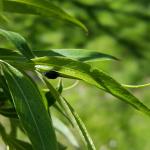 Imported Willow Leaf Beetle: Plagiodera versicolora adult beetles overwinter near susceptible hosts. A few adult imported willow leaf beetles were seen feeding on willow foliage in Chesterfield, MA on 5/11/19. Mating was not yet noticed at this location. Adult beetles will chew holes and notches in the leaves of willow. Adult beetles mate and lay eggs through the end of this month. Females lay yellow eggs in clusters on the undersides of leaves. Larvae are slug-like and bluish-green in color. They will feed in clusters and skeletonize the leaves. Most plants can tolerate the feeding from this insect, and foliage will appear brown. Repeated yearly feeding can be an issue, in which case management of the young larvae may be necessary. Take care with treatment in areas near water.
Imported Willow Leaf Beetle: Plagiodera versicolora adult beetles overwinter near susceptible hosts. A few adult imported willow leaf beetles were seen feeding on willow foliage in Chesterfield, MA on 5/11/19. Mating was not yet noticed at this location. Adult beetles will chew holes and notches in the leaves of willow. Adult beetles mate and lay eggs through the end of this month. Females lay yellow eggs in clusters on the undersides of leaves. Larvae are slug-like and bluish-green in color. They will feed in clusters and skeletonize the leaves. Most plants can tolerate the feeding from this insect, and foliage will appear brown. Repeated yearly feeding can be an issue, in which case management of the young larvae may be necessary. Take care with treatment in areas near water.
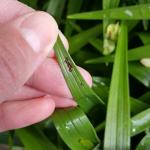 Lily Leaf Beetle: Lilioceris lilii overwintering adults have been reported by scouts in the Southeast Region previously. Adults overwintered in sheltered places and are now active with warm temperatures and available food sources. Although adult beetles were not seen during the chilly weather on 5/13/19 in Amherst, MA, previously laid eggs were located on host plant foliage in this location. Therefore, adult lily leaf beetles are active, mating, and laying eggs in Amherst at this time. As soon as susceptible hosts such as Lilium spp. (Turk’s cap, tiger, Easter, Asiatic, and Oriental lilies) and Fritillaria spp. break through the ground, the adult lily leaf beetles are known to feed on the new foliage. (Note: daylilies are not hosts.) Typically, in May, mating will occur and each female will begin to lay 250-450 eggs in neat rows on the underside of the foliage. If there are only a few plants in the garden, hand picking and destroying overwintering adults can help reduce local garden-level populations at this time.
Lily Leaf Beetle: Lilioceris lilii overwintering adults have been reported by scouts in the Southeast Region previously. Adults overwintered in sheltered places and are now active with warm temperatures and available food sources. Although adult beetles were not seen during the chilly weather on 5/13/19 in Amherst, MA, previously laid eggs were located on host plant foliage in this location. Therefore, adult lily leaf beetles are active, mating, and laying eggs in Amherst at this time. As soon as susceptible hosts such as Lilium spp. (Turk’s cap, tiger, Easter, Asiatic, and Oriental lilies) and Fritillaria spp. break through the ground, the adult lily leaf beetles are known to feed on the new foliage. (Note: daylilies are not hosts.) Typically, in May, mating will occur and each female will begin to lay 250-450 eggs in neat rows on the underside of the foliage. If there are only a few plants in the garden, hand picking and destroying overwintering adults can help reduce local garden-level populations at this time.
- Snowball Aphid: Neoceruraphis viburnicola becomes active on certain species of Viburnum roughly between 148-298 GDD’s or around redbud bloom. This insect is particularly noticeable on V. opulus, V. prunifolium, and V. acerifolia. Stem mothers, appearing blueish-white, can be found in curled up and distorted foliage. Damage caused by this insect pest is mostly aesthetic.
- Spotted Lanternfly: (Lycorma delicatula, SLF) is not known to occur in Massachusetts landscapes (no established populations are known in MA at this time). However, officials with the Massachusetts Department of Agricultural Resources (MDAR) recently urged residents to check plants for spotted lanternfly. On February 21, 2019 MDAR announced the discovery of a single dead spotted lanternfly adult at a private residence in Boston. As a result of this discovery, officials asked the public to check potted plants they purchase and report any suspicious insects. MDAR reports that this particular individual appeared to have been unintentionally transported this past December in a shipment of poinsettia plants originating from Pennsylvania. Officials also report that there is currently no evidence that this pest has become established in MA. For more information about this finding, please visit the MA Department of Agricultural Resources press release:https://www.mass.gov/news/state-agricultural-officials-urge-residents-to-check-plants-for-spotted-lanternfly .
This insect is a member of the Order Hemiptera (true bugs, cicadas, hoppers, aphids, and others) and the Family Fulgoridae, also known as planthoppers. The spotted lanternfly is a non-native species first detected in the United States in Berks County, Pennsylvania and confirmed on September 22, 2014.
The spotted lanternfly is considered native to China, India, and Vietnam. It has been introduced as a non-native insect to South Korea and Japan, prior to its detection in the United States. In South Korea, it is considered invasive and a pest of grapes and peaches. The spotted lanternfly has been reported from over 70 species of plants, including the following: tree of heaven (Ailanthus altissima) (preferred host), apple (Malus spp.), plum, cherry, peach, apricot (Prunus spp.), grape (Vitis spp.), pine (Pinus spp.), pignut hickory (Carya glabra), Sassafras (Sassafras albidum), serviceberry (Amelanchier spp.), slippery elm (Ulmus rubra), tulip poplar (Liriodendron tulipifera), white ash (Fraxinus americana), willow (Salix spp.), American beech (Fagus grandifolia), American linden (Tilia americana), American sycamore (Platanus occidentalis), big-toothed aspen (Populus grandidentata), black birch (Betula lenta), black cherry (Prunus serotina), black gum (Nyssa sylvatica), black walnut (Juglans nigra), dogwood (Cornus spp.), Japanese snowbell (Styrax japonicus), maple (Acer spp.), oak (Quercus spp.), and paper birch (Betula papyrifera).
The adults and immatures of this species damage host plants by feeding on sap from stems, leaves, and the trunks of trees. In the springtime in Pennsylvania (late April - mid-May) nymphs (immatures) are found on smaller plants and vines and new growth of trees and shrubs. Third and fourth instar nymphs migrate to the tree of heaven and are observed feeding on trunks and branches. Trees may be found with sap weeping from the wounds caused by the insect’s feeding. The sugary secretions (excrement) created by this insect may coat the host plant, later leading to the growth of sooty mold. Insects such as wasps, hornets, bees, and ants may also be attracted to the sugary waste created by the lanternflies, or sap weeping from open wounds in the host plant. Host plants have been described as giving off a fermented odor when this insect is present.
Adults are present by the middle of July in Pennsylvania and begin laying eggs by late September and continue laying eggs through late November and even early December in that state. Adults may be found on the trunks of trees such as the tree of heaven or other host plants growing in close proximity to them. Egg masses of this insect are gray in color and, in some ways, look similar to gypsy moth egg masses.
Host plants, bricks, stone, lawn furniture, recreational vehicles, and other smooth surfaces can be inspected for egg masses. Egg masses laid on outdoor residential items such as those listed above may pose the greatest threat for spreading this insect via human aided movement.
For more information about the spotted lanternfly, visit this fact sheet: https://ag.umass.edu/landscape/fact-sheets/spotted-lanternfly
- Spruce Spider Mite: Oligonychus ununguis is a cool-season mite that becomes active in the spring from tiny eggs that have overwintered on host plants. Hosts include spruce, arborvitae, juniper, hemlock, pine, Douglas-fir, and occasionally other conifers. This particular species becomes active in the spring and can feed, develop, and reproduce through roughly June. When hot, dry summer conditions begin, this spider mite will enter a summer-time dormant period (aestivation) until cooler temperatures return in the fall. This particular mite may prefer older needles to newer ones for food. When damaging spruce spider mite populations are known from last season, dormant oil applications can be made (when temperatures are appropriate according to label instructions) between 7-121 GDD’s, base 50°F. Magnification is required to view spruce spider mite eggs. Tapping host plant branches over white paper may be a useful tool when scouting for spider mite presence. (View with a hand lens.) Spider mite damage may appear on host plant needles as yellow stippling and occasionally fine silk webbing is visible.
- Viburnum Leaf Beetle: Pyrrhalta viburni is a beetle in the family Chrysomelidae that is native to Europe, but was found in Massachusetts in 2004. Tiny leaf beetle larvae can be seen feeding on the undersides of foliage at this time. This beetle feeds exclusively on many different species of Viburnum, which includes, but is not limited to, susceptible plants such as V. dentatum, V. nudum, V. opulus, V. propinquum, and V. rafinesquianum. Larvae, when they are present, may be treated with a product containing spinosad once they appear. Some Viburnum have been observed to have varying levels of resistance to this insect, including but not limited to V. bodnantense, V. carlesii, V. davidii, V. plicatum, V. rhytidophyllum, V. setigerum, and V. sieboldii. More information about Viburnum leaf beetle may be found at http://www.hort.cornell.edu/vlb/ .
- White Spotted Pine Sawyer (WSPS): Monochamus scutellatus will be pupating this month and adults can emerge in late May throughout July, depending on local temperatures. This is a native insect in Massachusetts and is usually not a pest. Larvae develop in weakened or recently dead conifers, particularly eastern white pine (Pinus strobus). However, the white spotted pine sawyer looks very similar to the invasive Asian Longhorned Beetle, Anoplophora glabripennis, ALB. ALB adults do not emerge in Massachusetts until July and August. Beginning in July, look for the key difference between WSPS and ALB adults, which is a white spot in the top center of the wing covers (the scutellum) on the back of the beetle. White spotted pine sawyer will have this white spot, whereas Asian longhorned beetle will not. Both insects can have other white spots on the rest of their wing covers; however, the difference in the color of the scutellum is a key characteristic. See the Asian longhorned beetle entry above for more information about that non-native insect.
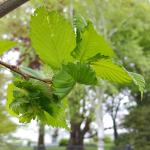 Woolly Apple Aphid: Eriosoma lanigerum may be found on apple, crabapple, hawthorn, mountain-ash, pyracantha, and elm hosts. The primary (winter) host is elm, on which aphids infest emerging spring leaves, causing leaves to curl or close into stunted, rosette-like clusters found at twig tips. Woolly apple aphid was observed on elm on 5/13/2019 in Amherst, MA. On apple and crabapple, this species of aphid colonizes roots, trunks, and branches in the summer and is commonly found near previous wounds or callous tissue. On roots, the aphids cause swelled areas which can girdle and kill roots. The aphids, when found in above ground plant parts such as elm leaves are covered with white wax. Eggs are the overwintering stage on elm, which hatch in the spring in time for the nymphs to infest new elm foliage. Following a few generations on elm, the aphids will develop into a winged form, which will disperse and seek out apple and crabapple. Multiple generations will occur on these alternate hosts in the summer and by the fall, a winged form will return to elm and mated females will lay eggs near elm buds.
Woolly Apple Aphid: Eriosoma lanigerum may be found on apple, crabapple, hawthorn, mountain-ash, pyracantha, and elm hosts. The primary (winter) host is elm, on which aphids infest emerging spring leaves, causing leaves to curl or close into stunted, rosette-like clusters found at twig tips. Woolly apple aphid was observed on elm on 5/13/2019 in Amherst, MA. On apple and crabapple, this species of aphid colonizes roots, trunks, and branches in the summer and is commonly found near previous wounds or callous tissue. On roots, the aphids cause swelled areas which can girdle and kill roots. The aphids, when found in above ground plant parts such as elm leaves are covered with white wax. Eggs are the overwintering stage on elm, which hatch in the spring in time for the nymphs to infest new elm foliage. Following a few generations on elm, the aphids will develop into a winged form, which will disperse and seek out apple and crabapple. Multiple generations will occur on these alternate hosts in the summer and by the fall, a winged form will return to elm and mated females will lay eggs near elm buds.
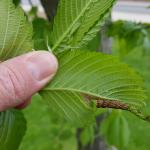 Woolly Elm Aphid: Eriosoma americanum females lay a single egg in the cracks and crevices of elm bark, where the egg overwinters. Eggs hatch on elm in the spring as leaves are unfolding. Curled leaves, due to the activity of the woolly elm aphid, were observed in Amherst, MA on 5/13/19. A young, wingless female hatched from the egg feeds on the underside of leaf tissue. This female aphid matures and gives birth to 200 young, all females, without mating. These aphids feed, and the elm leaf curls around them and protects them. By the end of June, winged migrants mature and find serviceberry hosts. Another set of females is produced. These new females crawl to and begin feeding on the roots of serviceberry. Multiple generations occur on the roots of serviceberry through the summer.
Woolly Elm Aphid: Eriosoma americanum females lay a single egg in the cracks and crevices of elm bark, where the egg overwinters. Eggs hatch on elm in the spring as leaves are unfolding. Curled leaves, due to the activity of the woolly elm aphid, were observed in Amherst, MA on 5/13/19. A young, wingless female hatched from the egg feeds on the underside of leaf tissue. This female aphid matures and gives birth to 200 young, all females, without mating. These aphids feed, and the elm leaf curls around them and protects them. By the end of June, winged migrants mature and find serviceberry hosts. Another set of females is produced. These new females crawl to and begin feeding on the roots of serviceberry. Multiple generations occur on the roots of serviceberry through the summer.
Concerned that you may have found an invasive insect or suspicious damage caused by one? Need to report a pest sighting? If so, please visit the Massachusetts Introduced Pests Outreach Project: http://massnrc.org/pests/pestreports.htm .
A note about Tick Awareness: deer ticks (Ixodes scapularis), the American dog tick (Dermacentor variabilis), and the lone star tick (Amblyomma americanum) are all found throughout Massachusetts. Each can carry their own complement of diseases. Anyone working in tick habitats (wood-line areas, forested areas, and landscaped areas with ground cover) should check themselves regularly for ticks while practicing preventative measures. Have a tick and need it tested? Visit the web page of the UMass Laboratory of Medical Zoology https://www.tickreport.com/ and click on the blue Order a TickReport button for more information.
Reported by Tawny Simisky, Extension Entomologist, UMass Extension Landscape, Nursery, & Urban Forestry Program
Additional Resources
To receive immediate notification when the next Landscape Message update is posted, be sure to join our e-mail list and follow us on Facebook and Twitter.
For a complete listing of upcoming events, see our Upcoming Educational Events page.
For commercial growers of greenhouse crops and flowers - Check out UMass Extension's Greenhouse Update website
For professional turf managers - Check out Turf Management Updates
For home gardeners and garden retailers - Check out home lawn and garden resources. UMass Extension also has a Twitter feed that provides timely, daily gardening tips, sunrise and sunset times to home gardeners, see https://twitter.com/UMassGardenClip
Diagnostic Services
A UMass Laboratory Diagnoses Landscape and Turf Problems - The UMass Extension Plant Diagnostic Lab is available to serve commercial landscape contractors, turf managers, arborists, nurseries and other green industry professionals. It provides woody plant and turf disease analysis, woody plant and turf insect identification, turfgrass identification, weed identification, and offers a report of pest management strategies that are research based, economically sound and environmentally appropriate for the situation. Accurate diagnosis for a turf or landscape problem can often eliminate or reduce the need for pesticide use. For sampling procedures, detailed submission instructions and a list of fees, see Plant Diagnostics Laboratory
Soil and Plant Nutrient Testing - The University of Massachusetts Soil and Plant Nutrient Testing Laboratory is located on the campus of The University of Massachusetts at Amherst. Testing services are available to all. The function of the Soil and Plant Nutrient Testing Laboratory is to provide test results and recommendations that lead to the wise and economical use of soils and soil amendments. For complete information, visit the UMass Soil and Plant Nutrient Testing Laboratory web site. Alternatively, call the lab at (413) 545-2311.
Ticks are active at this time! Remember to take appropriate precautions when working and playing outdoors, and conduct daily tick checks. UMass tests ticks for the presence of Lyme disease and other disease pathogens. Learn more.
